Research News
-
 10 10, 2017Prof. Kazuyoshi Hirota from Hirosaki University Graduate School of Medicine visits DICP
10 10, 2017Prof. Kazuyoshi Hirota from Hirosaki University Graduate School of Medicine visits DICP
Kazuyoshi Hirota, the Vice-Dean of Hirosaki University the Graduate School of Medicine, the Professor and Chairman of the Department of Anesthesiology in the medical school visited DICP from Sep. 5th to 7th, 2017. Prof. XU Guowang of the Laboratory of Biotechnology and Prof. LI Haiyang the Department of Instrumentation and Analytical Chemistry were in charge of his visit together. Prof. Hirota gave a lecture titled “Efficacy of Expiratory Anesthetic and VOCs Monitoring and Metabolomics in Future of Anesthesia Field” in the morning of Sep. 6th to describe the existing scientific problems to be solved urgently in precision anesthesia. He pointed out that in order to achieve personalized and accurate anesthesia, it is necessary to develop rapid detection techniques and equipment such as ion mobility spectrometry. And he also said necessity of protecting the functions of visceral organs and predicted the potential of metabolomics application in the perioperative period. He emphasized the importance of breath gas analysis.
He has more than 180 publications of original articles, review article and clinical reports being published in the English peer reviewed journals. He is a Fellow of Royal College of Anaesthetists elected (UK), the active member of Association of University Anesthesiologists (USA). (Text and Image by HOU Xiaoli) -
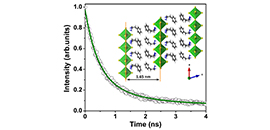 10 09, 2017DICP Scientists Develop a New Two-Dimensional Lead-Free PerovskiteThe research group led by Prof. HAN Keli from Dalian Institute of Chemical Physics (DICP), of the Chinese Academy of Sciences (CAS) has made a progress in the study of the dynamic mechanism of two-dimensional lead-free perovskite materials. This work has been published in The Journal of Physical Chemistry Letters.
10 09, 2017DICP Scientists Develop a New Two-Dimensional Lead-Free PerovskiteThe research group led by Prof. HAN Keli from Dalian Institute of Chemical Physics (DICP), of the Chinese Academy of Sciences (CAS) has made a progress in the study of the dynamic mechanism of two-dimensional lead-free perovskite materials. This work has been published in The Journal of Physical Chemistry Letters.
The research group led by Prof. HAN Keli from Dalian Institute of Chemical Physics (DICP) of the Chinese Academy of Sciences (CAS) has made a progress in the study of the dynamic mechanism of two-dimensional lead-free perovskite materials. This work has been published in The Journal of Physical Chemistry Letters.
Structural illustration of the layered 2D perovskite (PEA)2GeI4 and room-temperature PL spectrum of 2D (PEA)2GeI4 and 3D MAGeI3
Organic-inorganic hybrid perovskites are widely used in the photovoltaic field, in view of their high absorption coefficients, long charge carrier diffusion lengths, and simple manufacturing processes.
However, the heavy metal lead in these materials is toxic to organisms and the environment, and the stability of these material needs to be improved. Accordingly, it is important to develop lead-free and stable perovskite materials.
This group reported a lead-free, two-dimensional perovskite, (PEA)2GeI4 (PEA =C6H5(CH2)2NH3+). Structural characterization demonstrated that this 2D perovskite structure is formed with inorganic germanium iodide planes separated by organic PEAI layers.
(PEA)2GeI4 has a direct band gap of 2.12 eV, in agreement with 2.17 eV obtained by density functional theory (DFT) calculations, implying that it is suitable for a tandem solar cell. (PEA)2GeI4 luminesces at room-temperature with a moderate lifetime, exhibiting good potential for photovoltaic applications.
In addition, 2D (PEA)2GeI4 is more stable than 3D CH3NH3GeI3 in air, owing to the presence of a hydrophobic organic long chain.
This work provides a direction for the development of 2D Ge-based perovskites with potential for photovoltaic applications.
Previously, this group has achieved a series of research results on the mechanism of luminescence dynamics of lead-free perovskite nanocrystals (Angew. Chem. Int. Ed.) and lead-free double perovskite (New J. Chem.). (Text and Image by CHENG Pengfei) -
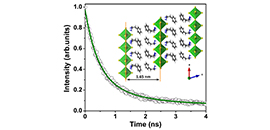 10 09, 2017DICP Scientists Develop a New Two-Dimensional Lead-Free PerovskiteThe research group led by Prof. HAN Keli from Dalian Institute of Chemical Physics (DICP), of the Chinese Academy of Sciences (CAS) has made a progress in the study of the dynamic mechanism of two-dimensional lead-free perovskite materials. This work has been published in The Journal of Physical Chemistry Letters.
10 09, 2017DICP Scientists Develop a New Two-Dimensional Lead-Free PerovskiteThe research group led by Prof. HAN Keli from Dalian Institute of Chemical Physics (DICP), of the Chinese Academy of Sciences (CAS) has made a progress in the study of the dynamic mechanism of two-dimensional lead-free perovskite materials. This work has been published in The Journal of Physical Chemistry Letters.
The research group led by Prof. HAN Keli from Dalian Institute of Chemical Physics (DICP) of the Chinese Academy of Sciences (CAS) has made a progress in the study of the dynamic mechanism of two-dimensional lead-free perovskite materials. This work has been published in The Journal of Physical Chemistry Letters.
Structural illustration of the layered 2D perovskite (PEA)2GeI4 and room-temperature PL spectrum of 2D (PEA)2GeI4 and 3D MAGeI3
Organic-inorganic hybrid perovskites are widely used in the photovoltaic field, in view of their high absorption coefficients, long charge carrier diffusion lengths, and simple manufacturing processes.
However, the heavy metal lead in these materials is toxic to organisms and the environment, and the stability of these material needs to be improved. Accordingly, it is important to develop lead-free and stable perovskite materials.
This group reported a lead-free, two-dimensional perovskite, (PEA)2GeI4 (PEA =C6H5(CH2)2NH3+). Structural characterization demonstrated that this 2D perovskite structure is formed with inorganic germanium iodide planes separated by organic PEAI layers.
(PEA)2GeI4 has a direct band gap of 2.12 eV, in agreement with 2.17 eV obtained by density functional theory (DFT) calculations, implying that it is suitable for a tandem solar cell. (PEA)2GeI4 luminesces at room-temperature with a moderate lifetime, exhibiting good potential for photovoltaic applications.
In addition, 2D (PEA)2GeI4 is more stable than 3D CH3NH3GeI3 in air, owing to the presence of a hydrophobic organic long chain.
This work provides a direction for the development of 2D Ge-based perovskites with potential for photovoltaic applications.
Previously, this group has achieved a series of research results on the mechanism of luminescence dynamics of lead-free perovskite nanocrystals (Angew. Chem. Int. Ed.) and lead-free double perovskite (New J. Chem.). (Text and Image by CHENG Pengfei) -
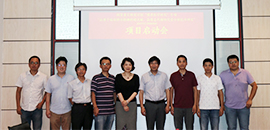 10 09, 2017The Launch of National Key R&D Program of China, Precision Medicine Project, is Held in DICP
10 09, 2017The Launch of National Key R&D Program of China, Precision Medicine Project, is Held in DICP
On September 1st, The launch of National Key R&D Program of China, Precision medicine project, "the development of ultra-sensitive and high-coverage technologies for quantitative metabolomics utilized in the clinic" was held in DICP.
The project leader, Prof. XU Guowang and the principal investigators from East China University of Science and Technology, Kunming Institute of Botany, CAS, Tsinghua University, the 6th hospital of Shanghai Jiao Tong University and Eastern Hepatobiliary Surgery Hospital attended the meeting.
The attendees studied the project and financial management of National Key R&D Program of China. The schedule for the tasks of each group was confirmed. The exchange and discussion mechanism was planned among the groups of the projects. And the cooperation among the groups was also coordinated during the meeting, which provided a good beginning of the project.
The project, "the development of ultra-sensitive and high-coverage technologies for quantitative metabolomics utilized in the clinic" collected multidisciplinary teams of metabolomics and related subjects in China. And the project aims to develop novel systemic techniques including chromatography-mass spectrometry, nuclear magnetic resonance, fluorescent probes and microfluidic chip, achieves ultra-sensitive, high-coverage, real time and in-situ measurements of metabolome in biological samples.
The developed techniques will be applied to the clinical studies of hepatocellular carcinoma and diabetes, provide support for diagnosis, sub-typing and treatment of diseases. (Text by YIN Peiyuan and Image by HOU Xiaoli)
-
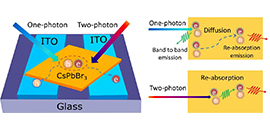 09 27, 2017DICP Scientists Develop an Ultra-Sensitive and Fast All-Inorganic Perovskite Based PhotodetectorScientists HAN Keli et al. from Dalian Institute of Chemical Physics (DICP) of the Chinese Academy of Sciences (CAS) use a solution growth method to prepare monocrystalline CsPbBr3 micro-crystals (MCs) with low trap-state density.
09 27, 2017DICP Scientists Develop an Ultra-Sensitive and Fast All-Inorganic Perovskite Based PhotodetectorScientists HAN Keli et al. from Dalian Institute of Chemical Physics (DICP) of the Chinese Academy of Sciences (CAS) use a solution growth method to prepare monocrystalline CsPbBr3 micro-crystals (MCs) with low trap-state density.
Large absorption coefficient, low trap-state density, higher carrier mobility of the absorber and efficient charge carrier transfer in the device are the key parameters for photodetectors with high sensitivtiy and fast response time.
Despite exciting progress, the current all-inorganic perovskites (AIP) based photodetectors suffer from limited responsivity (R) and slow photoresponse. For example, AIP quantum dots or bulk thin films based photodetectors have low R (normally< 10 A/W), which is due to the low carrier mobility and the high trap-state density in these materials.
Perovskite single crystal, with low trap-state density, can be a good candidate for fabricating photodetectors with high R and fast response. However, the photodectors with centimeter-size preovskite crystal show poor performance (R< 10 A/W), due to the device size which is about three orders of magnitude larger than the charge carrier diffusion length (μm), and the charge carriers cannot be extracted efficiently.
Schematic of the CsPbBr3 MC-based photodetector
Scientists HAN Keli et al. from Dalian Institute of Chemical Physics (DICP) of the Chinese Academy of Sciences (CAS) used a solution growth method to prepare monocrystalline CsPbBr3 micro-crystals (MCs) with low trap-state density. This work has been published in Advanced Materials.
They studied the photophysical properties of the CsPbBr3 MCs by using time-resolved photoluminescence (PL) spectroscopy under one-photon excitation (OPE) and two-photon excitation (TPE). Under OPE, the PL exhibits double peak emission and the PL decay dynamics show a wavelength dependence. Compared to OPE, the TPE PL shows single emission peak with longer PL lifetime. Moreover, the TPE PL decay is wavelength independent which is different from OPE.
They concluded that the PL properties with OPE are caused by the fast carrier diffusion and the CsPbBr3 MCs exhibit high carrier mobility (over 100 cm2V-1S-1). The CsPbBr3 MCs based photodetector exhibits high R up to 6×104 A/W (D*~1013) with OPE, this is the highest value among AIP based photodetectors. The photodetectors also exhibit fast response time (~1 ms), which corresponds to a gain of ~105 and a gain-bandwidth up to 108 Hz.
Furthermore, the CsPbBr3 MCs based photodetectors show high R up to 6 A/W in near-infrared (NIR) region under TPE.
This work was supported by the key research project of National Natural Science Foundation. (Text and Image by BIN Yang) -
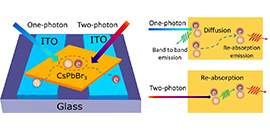 09 27, 2017DICP Scientists Develop an Ultra-Sensitive and Fast All-Inorganic Perovskite Based PhotodetectorScientists HAN Keli et al. from Dalian Institute of Chemical Physics (DICP) of the Chinese Academy of Sciences (CAS) use a solution growth method to prepare monocrystalline CsPbBr3 micro-crystals (MCs) with low trap-state density.
09 27, 2017DICP Scientists Develop an Ultra-Sensitive and Fast All-Inorganic Perovskite Based PhotodetectorScientists HAN Keli et al. from Dalian Institute of Chemical Physics (DICP) of the Chinese Academy of Sciences (CAS) use a solution growth method to prepare monocrystalline CsPbBr3 micro-crystals (MCs) with low trap-state density.
Large absorption coefficient, low trap-state density, higher carrier mobility of the absorber and efficient charge carrier transfer in the device are the key parameters for photodetectors with high sensitivtiy and fast response time.
Despite exciting progress, the current all-inorganic perovskites (AIP) based photodetectors suffer from limited responsivity (R) and slow photoresponse. For example, AIP quantum dots or bulk thin films based photodetectors have low R (normally< 10 A/W), which is due to the low carrier mobility and the high trap-state density in these materials.
Perovskite single crystal, with low trap-state density, can be a good candidate for fabricating photodetectors with high R and fast response. However, the photodectors with centimeter-size preovskite crystal show poor performance (R< 10 A/W), due to the device size which is about three orders of magnitude larger than the charge carrier diffusion length (μm), and the charge carriers cannot be extracted efficiently.
Schematic of the CsPbBr3 MC-based photodetector
Scientists HAN Keli et al. from Dalian Institute of Chemical Physics (DICP) of the Chinese Academy of Sciences (CAS) used a solution growth method to prepare monocrystalline CsPbBr3 micro-crystals (MCs) with low trap-state density. This work has been published in Advanced Materials.
They studied the photophysical properties of the CsPbBr3 MCs by using time-resolved photoluminescence (PL) spectroscopy under one-photon excitation (OPE) and two-photon excitation (TPE). Under OPE, the PL exhibits double peak emission and the PL decay dynamics show a wavelength dependence. Compared to OPE, the TPE PL shows single emission peak with longer PL lifetime. Moreover, the TPE PL decay is wavelength independent which is different from OPE.
They concluded that the PL properties with OPE are caused by the fast carrier diffusion and the CsPbBr3 MCs exhibit high carrier mobility (over 100 cm2V-1S-1). The CsPbBr3 MCs based photodetector exhibits high R up to 6×104 A/W (D*~1013) with OPE, this is the highest value among AIP based photodetectors. The photodetectors also exhibit fast response time (~1 ms), which corresponds to a gain of ~105 and a gain-bandwidth up to 108 Hz.
Furthermore, the CsPbBr3 MCs based photodetectors show high R up to 6 A/W in near-infrared (NIR) region under TPE.
This work was supported by the key research project of National Natural Science Foundation. (Text and Image by BIN Yang)